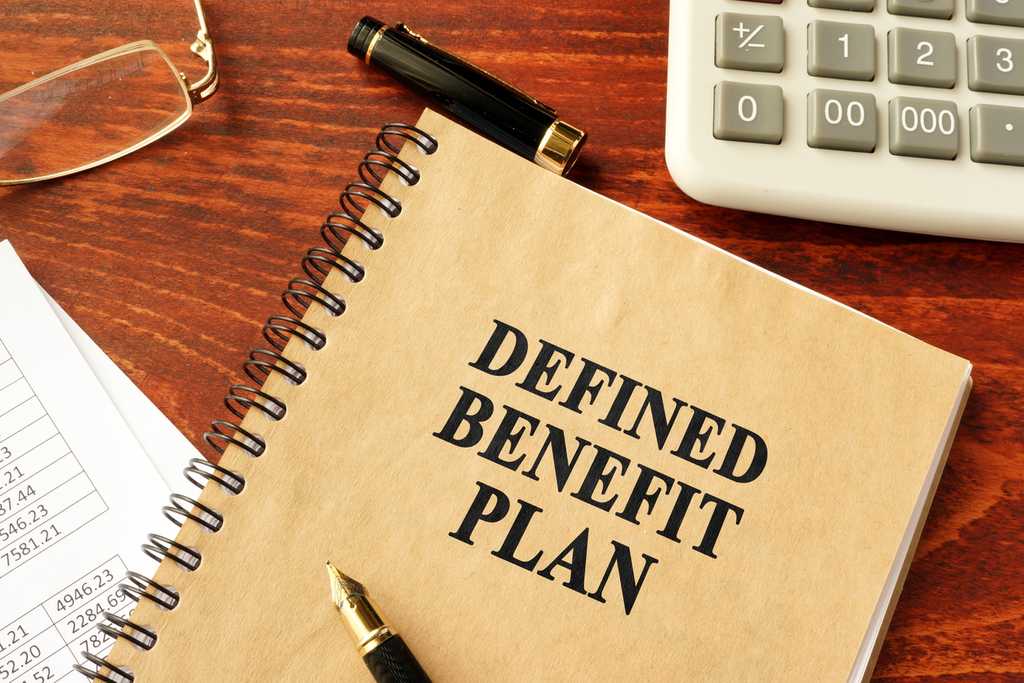A defined benefit plan, frequently referred to as a pension plan, is an employer-sponsored retirement plan that grants a specific, guaranteed benefit to plan participants upon their retirement. This benefit can come as a lump-sum payment or an annuity, paid over the lifetime of the retiree. Sometimes defined-benefit plans grant a surviving spouse benefits after the death of a plan participant.
Like other qualified retirement plans, employers can usually deduct contributions to the plans and you generally won’t owe tax on your defined-benefit plan until you start receiving distributions in retirement.
How Does a Defined Benefit Plan Work?
The beauty of a defined benefit plan is that an employee isn’t responsible for making investment decisions, unlike defined contribution plans. The key elements of a defined benefit plan are contributions, vesting and distributions.
Contributions
Defined-benefit plans are funded by contributions calculated from the expected cost of paying promised benefits. These payments are figured annually by actuaries hired by the plan who calculate the cost associated with new benefits earned during the year. From this amount of expected benefits, the actuaries determine an employer’s annual required contribution (ARC).
Traditionally, contributions to a defined benefit plan were typically made entirely by an employer in the private sector, but sometimes required employee contributions as well. In the public sector, contributions to defined benefit plans usually come both from employee and employer contributions.
Benefit Calculation and Vesting
Most defined-benefit plans require participants to be vested in the plan by having a certain number of years of service with their employer. Vesting schemes vary, but are typically based on years of service, which may be calculated based on some combination of work anniversary date, calendar year and number of hours worked during the year. Typically private pension plans vest after five to seven years.
The benefit you receive from a defined-benefit plan is a fixed amount calculated based on some combination of age, retirement age, years of service and salary. For salary, employers may use your final year’s salary, career average salary or the average earnings over a certain number of years. Some pension plans also reduce the amount of benefits by the amount of Social Security benefits you are expected to receive.
Distributions
When you retire, if you have vested in a defined-benefit plan you will receive a distribution from the plan. Defined benefit plans may distribute their promised benefits in a lump-sum payment or as an annuity paid to the plan beneficiary. Typically distributions come in one of the following forms:
Lump-sum distribution: The retirement benefit is paid in a lump-sum upon retirement. No further payments are made to plan beneficiaries or their survivors.
Single life annuity: Payments are made throughout retirement until the plan beneficiary dies. Payments end when the beneficiary dies and no benefit is granted to either a surviving spouse or a beneficiary’s heirs.
Joint and survivor annuity: Monthly benefits are paid for as long as either the beneficiary or their spouse is alive. Depending on the plan, a survivor may receive 100% of the beneficiary’s benefit or a reduced payment calculated by the plan. Some plans guarantee payments for survivors only if the plan beneficiary dies within a certain number of years.
Pros and Cons of Defined Benefit Plans
While some may consider defined benefit plans to be the gold standard of retirement plans, they are not for everyone or for every employer. Like many aspects of investing, financial planning and personal finance, there are tradeoffs with defined benefit plans.
Advantages
Certainty of payment amount: Defined benefit plans provide a known, guaranteed benefit to their beneficiaries. This means that once you have vested in your plan you can calculate the exact amount of the payment you will receive. If your plan provides benefits to a spouse or other beneficiary, they can also know the exact amount they will receive from the plan.
Simplicity: Defined benefit plans are managed by your employer and the plan selects its investments. Deciding which investments to make, balancing risk and return and fretting over market fluctuations isn’t something you will worry about with a defined benefit plan.
Employee retention: In the United States, defined benefit plans are increasingly rare, making them an attractive and unique employee benefit. In fact, in 2019 only 16 percent of private-sector workers had access to defined benefit plans. Additionally, the vesting periods associated with defined-benefit plans can provide an incentive for employees to stay with an employer. Employees who have not yet vested might stay with an employer in order to fully vest in their pension plan. Employees with more tenure might stay at an employer with a defined-benefit plan because they want to continue to accrue benefits under their pension plans.
Backed by the U.S. federal government: Some private and public pensions are insured up to an annual maximum by the United States federal government through the Pension Benefit Guaranty Corporation.
Disadvantages
Vesting period: Sometimes companies require that employees stay for several years before they vest in their defined-benefit retirement plan, which is known as cliff vesting. Some pensions vest gradually, for example, 20% in the first year, 40% in the second year, and so on. If you leave an employer before you are vested in your retirement plan, all of the money that the plan has earned stays with the company, though the money you contributed from your paychecks is yours.
Not portable: Unlike a 401(k) or similar defined-contribution plan, most defined benefit plans cannot be ported to another employer’s plan or rolled over into another qualified retirement plan. If you leave an employer with a vested pension, it is likely that your only option will be for that pension to remain with your previous employer, and you will not be able to accrue any additional benefits under the plan. Some plans offer former employees the option to receive a lump-sum payment of their benefits and some cash balance plans can be rolled over into another qualified retirement plan.
Fixed benefit amount: In a defined-benefit plan, your retirement benefit is based on a benefit formula, which means you can’t contribute more to your plan and receive a greater benefit in retirement.
You can’t inherit a pension: If the beneficiary of a defined-benefit plan dies, usually only a surviving spouse can access benefits if the plan allows it. Pension benefits can not be passed on to children, family members or heirs.
Cost of certainty: Generally, higher returns are associated with higher risk tolerance and more variability. On average, the amount of benefits paid under a defined-benefit plan could be less than the earnings you might receive from contributing a similar amount of money to an appropriately-managed defined contribution plan.
Defined Benefit Plans vs. Defined Contribution Plans
By a wide margin, more employers offer employees defined contribution plans, like 401(k) plans. These plans differ in how contributions are made and how benefits are paid. They also give participants more control and flexibility over their investment options.
Contributions: In a defined-benefit plan, contributions are usually made by the employer according to an annual required contribution (ARC) that is determined by actuaries based on the expected benefit amount. In a defined contribution plan, contributions are made by both employees and employers and employees can choose how much to contribute to their plans (up to plan or IRS maximums).
Choice of investments: Defined-benefit plans do not offer participants a choice of investments, while participants of defined-contribution plans can usually select among a wide variety of stocks, bonds, mutual funds, annuities and other investments.
Options for surviving spouse: In a defined-benefit plan, benefits are typically only granted to a surviving spouse after the plan beneficiary dies, and only if the plan allows that option. However, the balance in a defined contribution plan like a 401(k) or IRA can typically be passed on to additional named beneficiaries or as part of an estate.
Vesting: In a defined contribution plan, you don’t wait to “be invested” in the plan because you, not your employer, are making the contribution. The contributions made by your employer to a 401(k) also belong to you, the plan owner, from day one. Pensions and defined-contribution plans, on the other hand, are subject to plan vesting rules. If you make a contribution, you are entitled to that money before your vesting period is over, but you are not entitled to any employer contributions.
Portability: When you change jobs, you can usually roll over your 401(k) or other defined-contribution plan into your new employer’s plan or into an IRA. Defined benefit plans usually must remain with your old employer.
If your employer offers a defined benefit plan, know the rules
Defined-benefit plans provide a known benefit upon or during retirement to beneficiaries and can be a rock of certainty in your retirement plan if they are offered by your employer. However, with the advantage of certainty comes less flexibility.
Defined-benefit plans, unlike defined-contribution plans, allow for no control over underlying investments, are typically not portable and only allow a spouse as an additional beneficiary.

